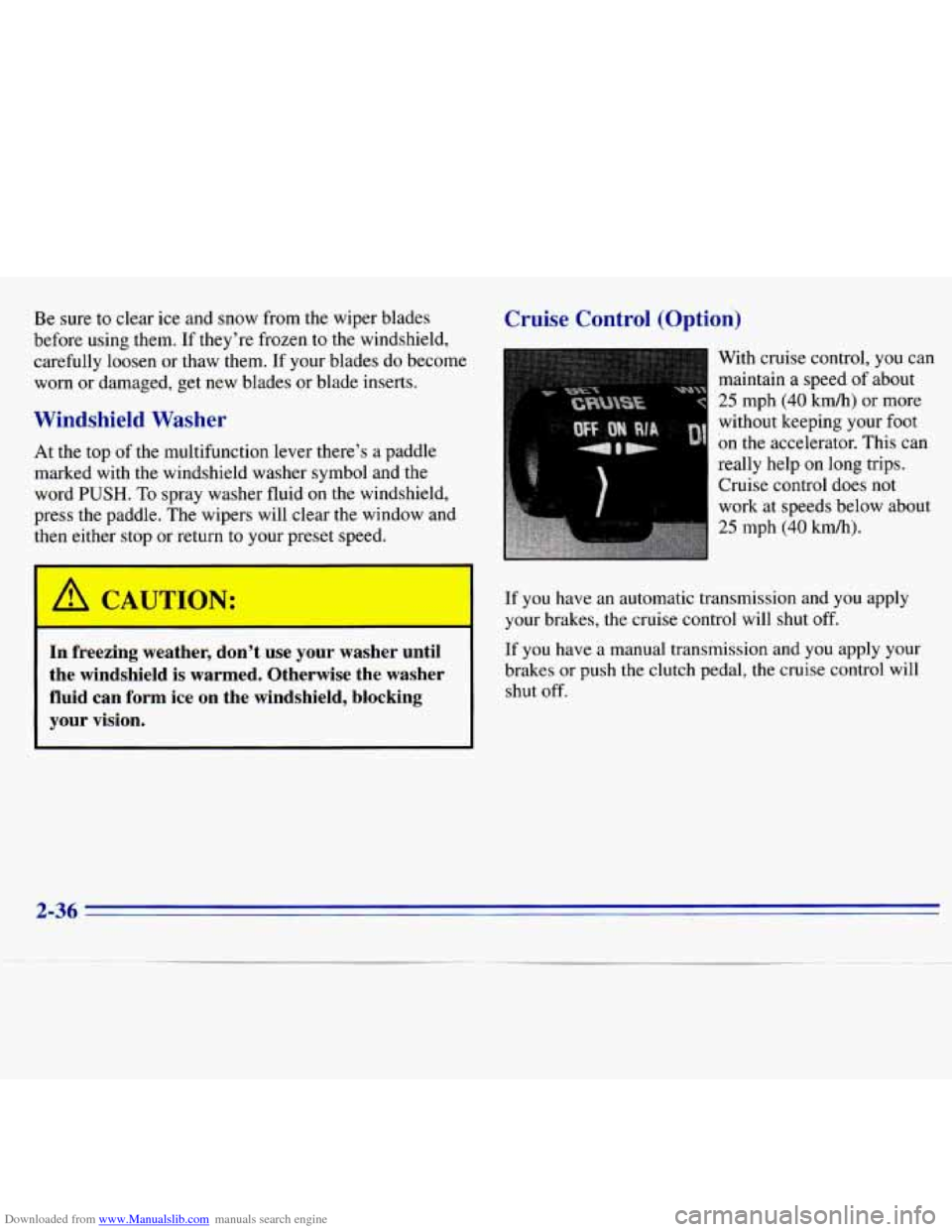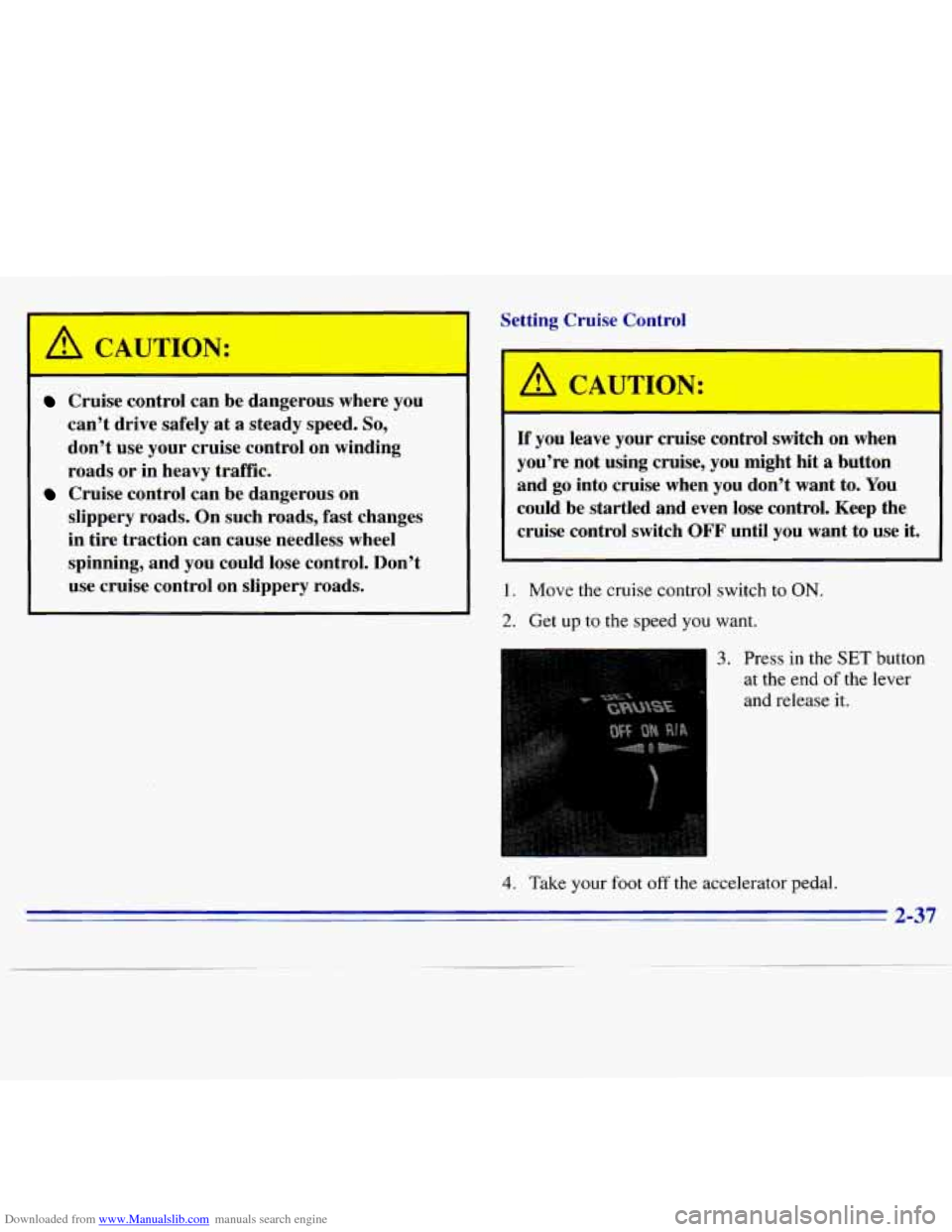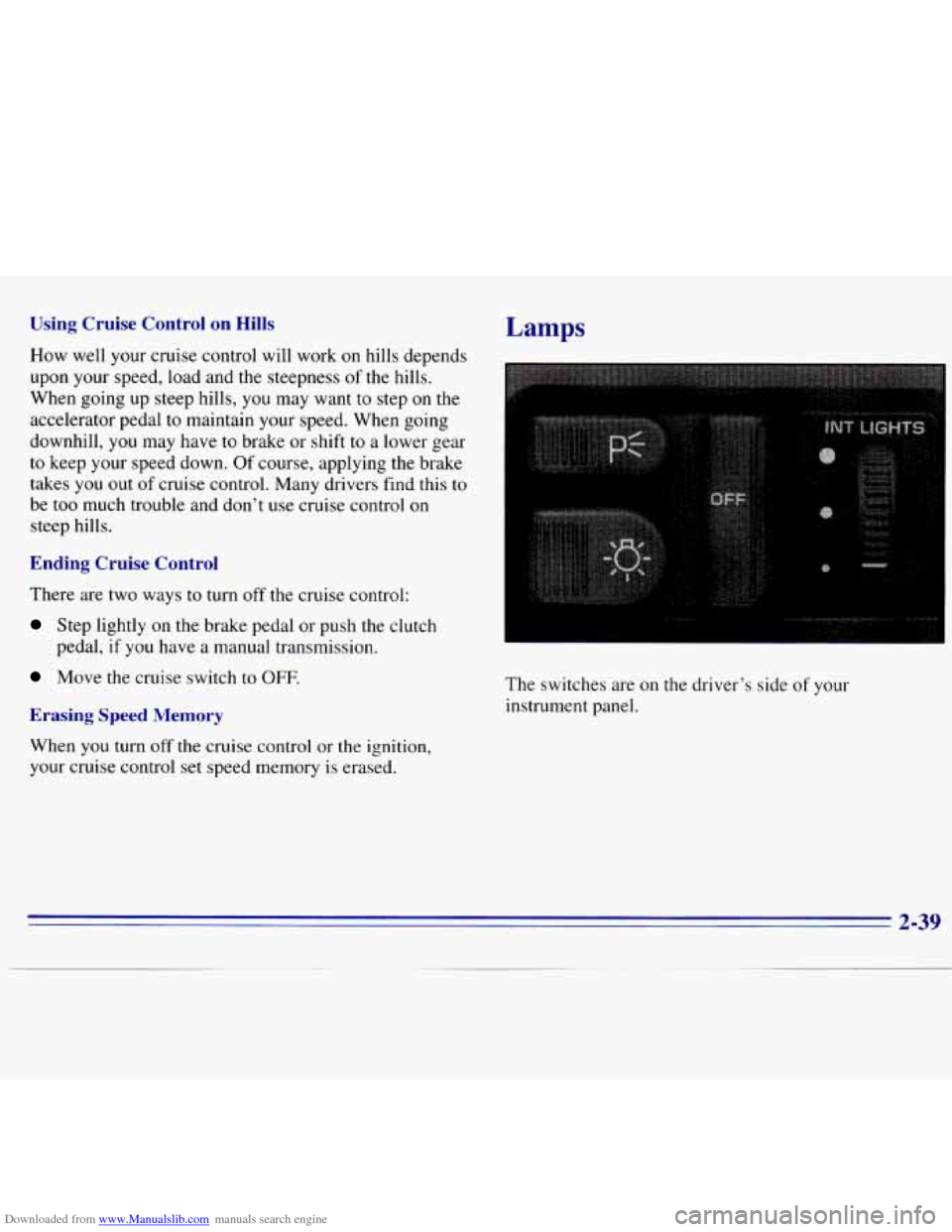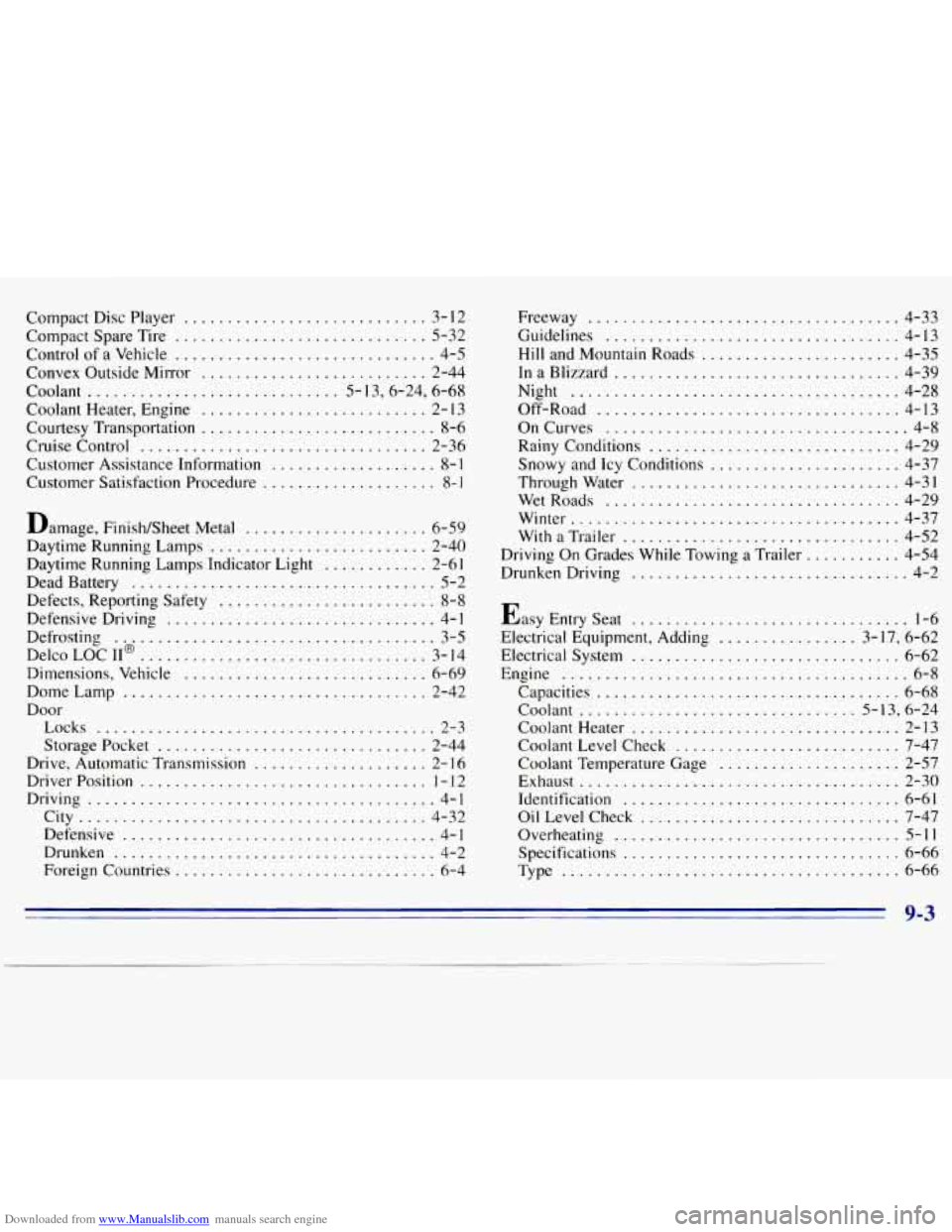1996 CHEVROLET S10 cruise control
[x] Cancel search: cruise controlPage 85 of 375

Downloaded from www.Manualslib.com manuals search engine Turn SignaVMultifunction Lever
The lever on the left side of the steering column
includes your:
0 Turn Signal and Lane Change Indicator
0 Headlamp HighLow Beam Changer
0 Windshield Wipers
Windshield Washer
0 Cruise Control (Option)
Turn and Lane Change Signals
The turn signal has two upward (for right) and two
downward (for left) positions. These positions allow
you
to signal a turn or a lane change.
To signal a turn, move the lever all the way up or
down. When the turn is finished, the lever will
return automatically.
An arrow on the instrument
panel will flash in the
direction of the turn or
lane change.
To signal a lane change, just raise or lower the lever
until the arrow starts to flash. Hold it there until you
complete your lane change. The lever will return by
itself when you release
it.
As you signal a turn or a lane change, if the arrows don’t
flash but just stay on, a signal bulb may be burned out
and other drivers won’t see your turn signal.
2-34
Page 87 of 375

Downloaded from www.Manualslib.com manuals search engine Be sure to clear ice and snow from the wiper blades
before
using them. If they’re frozen to the windshield,
carefully loosen or thaw them.
If your blades do become
worn or damaged, get new blades or blade inserts.
Windshield Washer
At the top of the multifunction lever there’s a paddle
marked with the windshield washer symbol and the
word
PUSH. To spray washer fluid on the windshield,
press the paddle. The wipers will clear the window and
then either stop or return to your preset speed.
Cruise Control (Option)
With cruise control, you can
maintain a speed
of about
25 mph (40 km/h) or more
without keeping your
foot
on the accelerator. This can
really help on long trips.
Cruise control does not
work at speeds below about
25 mph (40 km/h).
-’ C SJTIC -J: If you have an automatic transmission and you apply
-- your brakes, the cruise control will shut off.
In freezing weather, don’t use your washer until If you have a manual transmission and you apply your
the windshield is warmed. Otherwise the washer brakes or push the clutch pedal, the cruise control will
fluid can form ice on the windshield, blocking shut off.
your vision.
2-36
Page 88 of 375

Downloaded from www.Manualslib.com manuals search engine Cruise control can be dangerous where you
can’t drive safely at a steady speed.
So,
don’t use your cruise control on winding
roads or in heavy traffic.
slippery roads. On such roads, fast changes in tire traction can cause needless wheel
spinning, and you could lose control. Don’t
use cruise control on slippery roads.
Cruise control can be dangerous on
Setting Cruise Control
‘
A CAUTION:
r
-
If you leave your cruise control switch on when
you’re not using cruise, you might hit
a button
and go into cruise when you don’t want to.
You
could be startled and even lose control. Keep the
cruise control switch
OFF until you want to use it.
1. Move the cruise control switch to ON.
2. Get up to the speed you want.
3. Press in the SET button
at the end
of the lever
and release it.
4. Take your foot off the accelerator pedal.
2-37
Page 90 of 375

Downloaded from www.Manualslib.com manuals search engine Using Cruise Control on Hills
How well your cruise control will work on hills depends
upon your speed, load and the steepness
of the hills.
When going up steep hills,
you may want to step on the
accelerator pedal to maintain your speed. When going
downhill,
you may have to brake or shift to a lower gear
to keep your speed down. Of course, applying the brake
takes you out of cruise control. Many drivers find
this to
be too much trouble and don’t use cruise control on
steep hills.
Ending Cruise Control
There are two ways to turn off the cruise control:
Step lightly on the brake pedal or push the clutch
pedal, if
you have a manual transmission.
Move the cruise switch to OFF.
Erasing Speed Memory
When you turn off the cruise control or the ignition,
your cruise control set speed memory is erased.
Lamps
The switches are on the driver’s side of your
instrument panel.
2-39
Page 347 of 375

Downloaded from www.Manualslib.com manuals search engine Part C: Periodic Maintenance
Inspections
Listed below are inspections and services which should
be perfowed at least twice a year (for instance, each
spring and fall). You should let your GM dealer’s
service department or other qualified service center do
these
jobs. Make sure any necessary repairs are
completed at once.
Proper procedures to perform these services may be
found in a service manual. See “Service and Owner
Publications’’ in the Index.
Steering and Suspension Inspection
Inspect the front and rear suspension and steering
system for damaged, loose or missing parts, signs of
wear or lack of lubrication. Inspect the power steering
lines and hoses for proper hook-up, binding, leaks,
cracks, chafing, etc.
Exhaust System Inspection
Inspect the complete exhaust system. Inspect the body near
the exhaust system. Look for broken, damaged, missing or
out-of-position parts
as well as open seams, holes, loose
connections or other conditions which could cause a heat
build-up in the floor pan or could let exhaust fumes into
the vehicle. See “Engine Exhaust” in the Index.
Radiator and Heater Hose Inspection
Inspect the hoses and have them replaced if they are
cracked, swollen or deteriorated; Inspect all pipes,
fittings and clamps; replace as needed.
Throttle Linkage Inspection
Inspect the throttle linkage for interference or binding,
and for damage or missing parts. Replace parts as
needed. Replace any cables that have high effort or
excessive wear.
Do not lubricate accelerator and cruise
control cables.
7-51
Page 367 of 375

Downloaded from www.Manualslib.com manuals search engine Compact Disc Player ............................ 3- I2
Compact Spare Tire ............................. 5-32
Control of
a Vehicle .............................. 4-5
Convex Outside Mirror
.......................... 2-44
Coolant
............................. 5- 13.6.24. 6.68
Coolant Heater. Engine .......................... 2- I3
Courtesy Transportation ........................... 8-6
Cruise Control ................................. 2-36
Customer Assistance Information
................... 8-1
Customer Satisfaction Procedure .................... 8- 1
Damage. Finish/Sheet Metal ..................... 6-59
Daytime Running Lamps ......................... 2-40
Daytime Running Lamps Indicator Light
............ 2-61
Dead Battery
................................... 5-2
Defects. Reporting Safety ......................... 8-8
Defensive Driving ............................... 4- I
Defrosting .................................... 3-5
Delco LOC 11' ................................. 3- 14
Dimensions. Vehicle
............................ 6-69
DomeLamp ................................... 2-42
Door Locks
....................................... 2-3
StoragePocket
............................... 2-44
Drive. Automatic Transmission
.................... 2- 16
DriverPosition ................................. 1-12
Driving
........................................ 4-1
City ........................................ 4-32
Defensive
.................................... 4-1
Drunken ..................................... 4-2
Foreign Countries
.............................. 6-4 Freeway
.................................... 4-33
Guidelines
.................................. 4-13
Hill and Mountain Roads
....................... 4-35
InaBlizzard
................................. 4-39
Night
...................................... 4-28
Off-Road
................................... 4-13
OnCurves
................................... 4-8
Rainy Conditions
............................. 4-29
Snowy and Icy Conditions
...................... 4-37
Throughwater
............................... 4-31
WetRoads
.................................. 4-29
Winter
...................................... 4-37
With
a Trailer ................................ 4-52
DrunkenDriving
................................ 4-2
Driving
On Grades While Towing
a Trailer ........... 4-54
Easy Entry Seat
................................ 1-6
Electrical Equipment. Adding ................ 3-1.7, 6-62
Electrical System
............................... 6-62
Capacities
................................... 6-68
Coolant ................................ 5- 13. 6-24
Coolant Heater ............................... 2-13
Coolant Level Check
.......................... 7-47
Coolant Temperature Gage
..................... 2-57
Exhaust
..................................... 2-30
Identification ................................ 6-61
OilLevelCheck
.............................. 7-47
Overheating
................................. 5-11
Specifications ................................ 6-66
Type ........................................ 6-66
Engine
........................................ 6-8
9-3